Success Stories: Disease Detectives in Ethiopia, Part 1
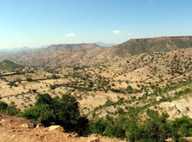
Arid, mountainous terrain of Tigray
A strange new illness was spreading throughout Tigray, the northern region of Ethiopia. In this dry, mountainous area, people living in remote homes and villages were coming down with what appeared to be the same unknown disease. Residents of Tigray were all too familiar with the tropical diseases common in this region, and they recognized this illness was not one of them. But what was it?
People who contracted the disease developed swollen, painful abdomens and then lost weight. Some of them had trouble breathing as the fluid in their abdomens crowded against their lungs. Three or four family members in one household might become ill, while others living in the same household did not. However, in some families, everyone died from the disease. Children as young as two years old could be healthy and active, but three days later, their abdomens were swollen with up to four liters of fluid. After a while, they became too weak to move.
People were ill, even dying, from an illness that demonstrated symptoms commonly seen in liver disease. But what was causing it?
The Investigation Begins
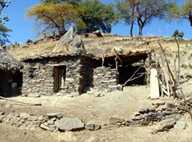
Home in the rural area of Tigray
This was the situation in Tigray in 2007, when the Ethiopia Ministry of Health and Ethiopia Health and Nutrition Research Institute (EHNRI) asked CDC’s Health Studies Branch and other partners to help them investigate the outbreak of what was then called “unidentified liver disease(ULD).”
Since 2005, more than 1,200 people had been diagnosed with the condition and many had died. The joint epidemiologic investigation in 2007 ruled out infectious diseases as the cause and suggested that the disease may be related to food people were eating. But EHNRI already suspected that the cause of the outbreak was something in the environment.
A year later, environmental health experts Matthew Murphy, PhD, MS; Colleen Martin, MSPH; Richard Luce, DVM, MPH; and Danielle Rentz, PhD, MPH, travelled to Tigray. They helped Ethiopian health agencies conduct another investigation to understand the risk factors for the disease. Epidemiological teams walked to remote villages and homes, some as far as four hours away, to gather information from households.
Martin has vivid memories of her time in Ethiopia. “It was so sad to see small children with their swollen bellies, so sick they could not move,” she said. But these conditions just made her more determined.
Although they still did not find a definite cause for ULD in 2008, the epidemiologists narrowed the list of possibilities. They discovered low levels of two particular types of pyrrolizidine alkaloids (PAs), which are a large class of plant-based liver toxins, in grain samples taken from household farms where people had ULD. The toxin was found in a common type of weed that grew and was harvested along with the grain.
Scientists believed that the cause of the outbreak might be exposure to toxic PAs from eating contaminated grain or animal products, but too many uncertainties remained. The levels of PAs in grain samples were too low to cause acute or chronic illness and had never been associated with toxicity before.
Doctors had not been able to document completely the course of the disease in patients. Epidemiologic risk factors for illness were unclear. No laboratory test existed that could evaluate human serum (blood) for evidence of PA exposure.
The Plot Thickens
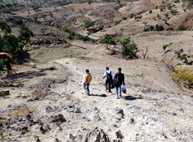
Field workers set off on their long walk to collect data.
HSB epidemiologists knew they needed more information to come to solid conclusions, so they recommended collecting more grain and other food samples for testing, establishing a surveillance system, and collecting additional evidence from ULD patients to better describe characteristics of the disease.
Following these recommendations in 2009, EHNRI established a surveillance system. And in 2011, they once again requested CDC assistance to develop tools to collect physical evidence from ULD patients and additional samples for PA testing. Epidemiologists Danielle Buttke, DVM, PhD, MPH; Ellen Yard, PhD; Richard Luce; and Tesfaye Bayleyegn, MD, travelled to Ethiopia to contribute their expertise, while Colleen Martin provided oversight from Atlanta.
CDC’s Work Saves Lives Everywhere, Every Day
CDC′s mission, simply put, is to keep Americans safe and healthy where they work, live, and play. Scientists and disease detectives work around the world to track diseases, research outbreaks, respond to emergencies of all kinds, and use what they learn from this work to develop and advocate public health policies that strengthen America′s health and resilience.
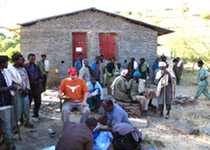
Epidemiologist Matthew Murphy organizes the team for fieldwork outside a health station
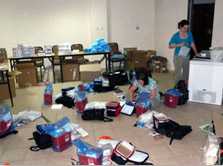
Colleen Martin and Danielle Rentz organize supplies for field Workers. Later, they would turn this room into a 'lab,' complete with centrifuge and freezer.
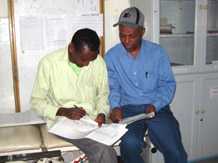
CDC's Tesfaye Beyleyegn and EHNRI's Hailemariam Hailemichael at a regional hospital.
- Page last reviewed: August 12, 2013
- Page last updated: August 12, 2013
- Content source:


 ShareCompartir
ShareCompartir